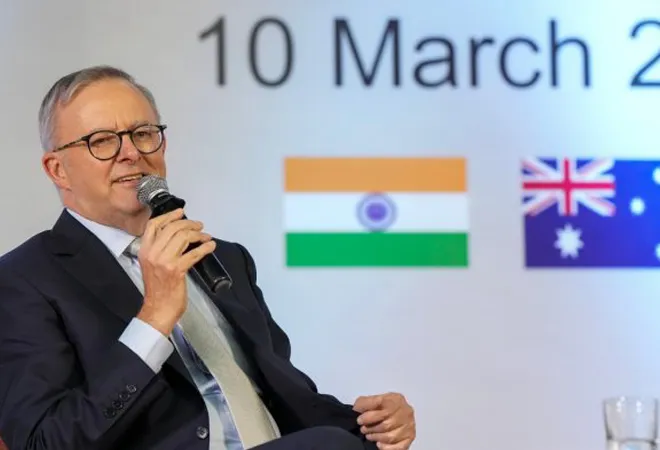
Australia’s Prime Minister Anthony Albanese recently embarked on a four-day state
visit to India from 8 March to 11 March 2023 at the invitation of Prime Minister Modi. Prime Minister Albanese’s visit is
aimed to further strengthen “strategic, economic and people to people ties with India, a close friend and partner to Australia.” A
statement released by the Australian Prime Minister’s Office prior to his visit mentioned that PM Albanese would be attending the Australia-India Annual Leaders’ Summit in New Delhi. It further
stated that “the Prime Ministers will discuss trade and investment, renewable energy, technology, defence and security cooperation, strong educational and cultural ties.” During this visit, PM Albanese has been
accompanied by Trade and Tourism Minister Don Farrell and Resources Minister Madeleine King along with senior-level officials and a high-profile business delegation. This visit marks the first bilateral visit by the Australian Prime Minister since his Labour Government came to power in May 2022.
According to PM Albanese, “A stronger India-Australia partnership is good for the stability of our region. It also means more opportunities and more trade and investment, strengthening our economies and directly benefiting our people.”
He announced that India would be joining the Talisman Sabre war games in Australia this year, which is held every two years in a designated Australian Defence Force training facility in Queensland and areas around the Coral Sea.
On 9 March 2023, PM Albanese visited INS Vikrant in Mumbai, India’s indigenous aircraft carrier and
pointed out, “For Australia, India is a top-tier security partner. The Indian Ocean is central to both countries’ security and prosperity. And there has never been a point in both our country’s histories where we have had such a strong strategic alignment. We both depend on free and open access to sea lanes in the Indo-Pacific for our trade and economic well-being.” He further
added, “My visit to India reflects my government’s commitment to place India at the heart of Australia’s approach to the Indo-Pacific and beyond.” He
announced that India would be joining the Talisman Sabre war games in Australia this year, which is held every two years in a designated Australian Defence Force training facility in Queensland and areas around the Coral Sea. Australia will also be hosting the Malabar exercises comprising the navies of India, Japan, the United States (US) and Australia this year as well. The two leaders also
welcomed the “initiatives being taken by the two countries for maritime domain awareness in the Indian Ocean, increased defence information sharing and consolidation of mutual access that continue to deepen operational defence cooperation.” The level of engagement between the two countries has further intensified in the last year with “more exercises, dialogues, operations than ever before”. Not only did key developments take place in the domain of security but also in other sectors like clean energy, rare earth minerals, education, all aimed at strengthening this partnership further.
Both India and Australia have realised the importance and potential of working together towards maintaining a stable regional order in the larger Indo-Pacific.
The India-Australia bilateral relations have transformed exponentially in the last five years, and this can majorly be attributed to strong political will from both sides as well as due to the shared concerns, interests, and vision of preserving a free, open, inclusive and rules-based Indo-Pacific region. The need for a free and open Indo-Pacific forms the nucleus of both countries’ foreign policies. Both India and Australia have realised the importance and potential of working together towards maintaining a stable regional order in the larger Indo-Pacific. This change in outlook is undoubtedly also due to the transformation that has taken place in how the two countries are viewing and reacting to the growing China challenge. There has clearly been a change in the China policy of both India and Australia. Both the countries in dealing with the China threat were aiming to diversify their partnerships in the economic sphere primarily, but also in defence, clean energy, and critical and resilient supply chains, among others. This naturally gave a strong push to the India-Australia bilateral ties.
India’s deepening relations with Australia have played a critical role in how India’s own ambitions and policies in the Indo-Pacific have evolved. Both countries are an integral part of the Quad—a regional minilateral grouping comprising India, Japan, Australia and the US— and are also shaping the agenda of this grouping. Though the idea of the free and open Indo-Pacific and the Quad was initially mainly championed by Japan, both Australia and India’s inclusion and active participation alongside the US has made it a potential cooperative framework in the Indo-Pacific. From Australia and India both being hesitant and not at all keen to be a part of the Quad 1.0 to Australia hosting the Quad Leaders’ Summit and the Malabar exercises this year, there indeed has been a sea change in Australia’s own foreign policy outlook. This is very similar to India’s own journey, from being a shy member of the Quad grouping to being an active player, vociferously putting forward its own national interests while also working closely with the Quad partner countries to make the grouping a substantial one. The fact that India’s position is noteworthy and central in the Indo-Pacific has been accepted by Australia and this is reflected in Australia’s and other Quad countries’ recognition of the fact that India can have a varied position on global issues which will be in line with its own national interests, despite of being a part of the Quad. An example in sight is India’s neutral stand on the Ukraine Crisis.
The fact that India’s position is noteworthy and central in the Indo-Pacific has been accepted by Australia and this is reflected in Australia’s and other Quad countries’ recognition of the fact that India can have a varied position on global issues which will be in line with its own national interests, despite of being a part of the Quad.
This visit also clearly puts across one message from the Australian side, that this relationship needs to delve much deeper than just strategic and security issues. The agenda of the first India-Australia Annual Summit held on 10 March 2023 clearly is reflective of that. Additionally, PM Albanese
chaired many key meetings focussing on renewable energy, trade, and education.
According to MEA Spokesperson, Arindam Bagchi, “An extensive agenda is on the table, focusing on economy & trade, defence & security, S&T, energy, education, mobility and diaspora, as well as regional & multilateral issues.”
But trade formed the focal point of this bilateral meeting. In December 2022, the two countries
signed the India-Australia Economic Cooperation and Trade Agreement (ECTA). The goal now is to elevate the ECTA to a Comprehensive Strategic Economic Partnership Agreement. The ECTA has already
resulted in the reduction of duty to zero on 96 percent of Indian exports to Australia in value and zero duty on 85 percent of Australia’s exports to India. According to Indian analysts, there is
potential for bilateral trade to rise to US $50 billion in the next five years with the signing of the ECTA. Before this visit, in Sydney, PM Albanese had
stated, “greater diversity in who we trade with - and greater variety in what we trade, meaning our economy is more resilient and more secure”. There has still not been much investment by Australian companies towards Indian businesses till now, but there is a growing realisation that the Australian corporate sector needs to invest more in India. In that context, the India-Australia CEO Forum which was held in Mumbai as a part of this visit is a step in the right direction. The joint statement released after the summit
mentions that the CEO forum delved into “exploring emerging economic and investment opportunities, and to leverage the significant complementarities of the two economies.” The clean and green energy sector seems to present the
most potential- “Australia’s comparative strength in raw materials, critical minerals and innovative research coupled with India’s scale, market size and low-cost manufacturing space can lead to fruitful and mutually beneficial outcomes through partnerships between Indian and Australian companies.” More efforts are needed to strengthen existing mechanisms like the Supply Chain Resilience Initiative (SCRI) between Australia, India and Japan. Therefore, the leaders
stressed on the need for “building secure, resilient and sustainable critical minerals supply chains essential for clean energy, electric vehicles, semiconductors, aerospace and defence.”
There are some other potential areas of collaboration which also the two countries need to explore.
There are some other potential areas of collaboration which also the two countries need to explore. First, how can Australia help facilitate India’s greater involvement in the South Pacific; second, how can Australia help India work with the Indian Ocean island countries in dealing with growing climate change challenges, including what lessons India can draw from Australia’s own experience with the Pacific island nations who deal with similar hardships; third, given Australia is a part of the Coalition for Disaster Resilient Infrastructure Initiative (CDRI), how Australia can work with India as a part of this initiative in the Western Indian Ocean Region; fourth, what initiatives can India and Australia undertake together in Southeast Asia, how the two countries can be involved more in ASEAN-led mechanisms like the East Asia Summit (EAS); fifth, given Australia is already the lead in the marine resources pillar of India’s Indo-Pacific Initiative, what can the two countries do to bring more ASEAN countries and Indian Ocean rim countries to be a part of this pillar and lastly; how can the two countries make the Indian Ocean Rim Association (IORA) more effective and meaningful. This relationship has without a doubt come a long way, but there is scope for much more to help realise the true value of the Comprehensive Strategic Partnership.
The views expressed above belong to the author(s). ORF research and analyses now available on Telegram! Click here to access our curated content — blogs, longforms and interviews.



 Australia’s Prime Minister Anthony Albanese recently embarked on a four-day state
Australia’s Prime Minister Anthony Albanese recently embarked on a four-day state  PREV
PREV


